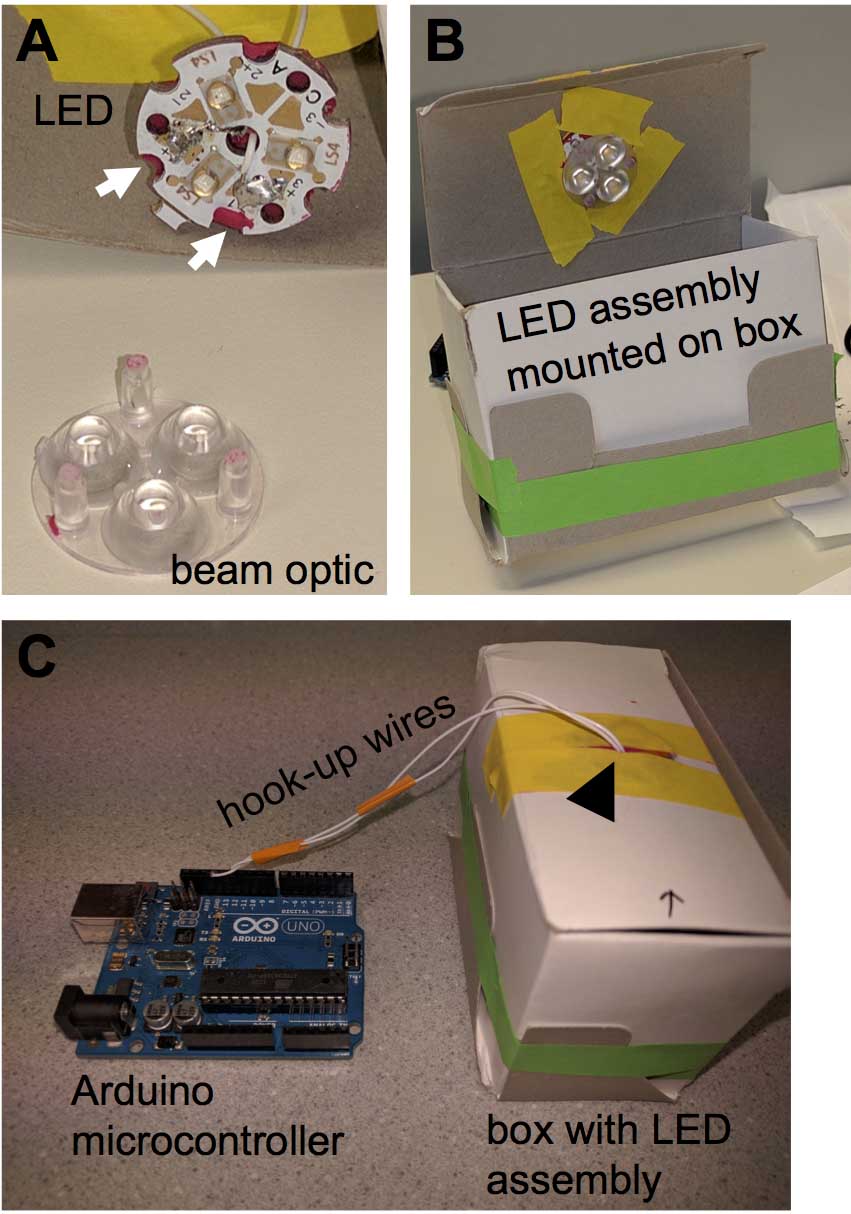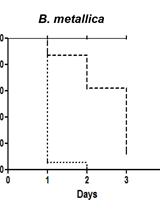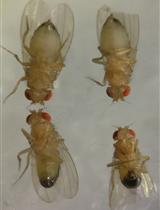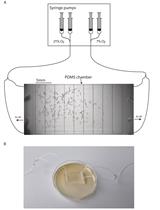- EN - English
- CN - 中文
Artificial Optogenetic TRN Stimulation of C. elegans
人工光基因刺激线虫触觉神经实验
发布: 2016年10月20日第6卷第20期 DOI: 10.21769/BioProtoc.1966 浏览次数: 8582
评审: Peichuan ZhangPengpeng LiAnonymous reviewer(s)
Abstract
Optogenetics is a powerful tool for manipulating neuronal activity with high temporal and spatial precision. In the nematode C. elegans optogentics is especially useful and easy to apply. This is because C. elegans is translucent, so its neurons are highly accessible to optic stimulation. In addition, many of its neurons can be exclusively targeted using cell-specific promoters. We have recently taken advantage of optogenetics to deliver artificial patterns of prolonged activation to a class of mechanosensory neurons, called touch receptor neurons (TRNs) in worms that lack touch sensation due to a genetic mutation. Our aim was to examine whether we can counteract the effects of sensory loss by artificially activating the sensory neurons. Here we describe in detail the various components of the protocol that we used. This consists of exposing worms expressing the light-sensitive ion channel Channelrohdopsin 2 (ChR2) in TRNs to long-term random flashes of light.
Keywords: Optogenetics (光遗传学)Background
Artificial optogenetic stimulation (or silencing) of neurons has become of broad use in neuroscientific research. The powerful model organism, C. elegans, is particularly amenable to optogenetic manipulation (Nagel et al., 2005), and multiple groups have developed a range of techniques for delivering artificial brief patterns of stimulation with high temporal and spatial precision (Leifer et al., 2011; Stirman et al., 2011) and in combination with behavioral (Kocabas et al., 2012) and calcium imaging (Guo et al., 2009) or electrophysiological (Lindsay et al., 2011) readouts. We were interested in establishing a long-term stimulation protocol that would substitute natural ongoing activity in mechanosensory neurons deprived of sensory input (Rabinowitch et al., 2016). Our protocol integrates previous C. elegans optogenetic protocols, but focuses on chronic rather than transient stimulation.
Materials and Reagents
- 1.7 ml microtubes (Genesee Scientific, catalog number: 24-282 )
- Aluminum foil
- 60 x 15 mm cultivation/test plates (Genesee Scientific, catalog number: 32-105G )
- 35 x 10 mm stimulation plates (Genesee Scientific, catalog number: 32-103 )
- C. elegans strains
- TU253 mec-4(u253) X (a mutant strain deficient in TRN mechanosensation). mec-4 encodes an amiloride-sensitive Na+ channel protein (degenerin) expressed exclusively in the TRNs and required to sense gentle mechanical stimuli (e.g., touch) along the body wall (www.wormbase.org)
- BJH255 mec-4(u253) X; ljIs111[Pmec-4::ChR2]
- TU253 mec-4(u253) X (a mutant strain deficient in TRN mechanosensation). mec-4 encodes an amiloride-sensitive Na+ channel protein (degenerin) expressed exclusively in the TRNs and required to sense gentle mechanical stimuli (e.g., touch) along the body wall (www.wormbase.org)
- The second strain combines both defective TRN mechanosensation and ChannelRhodopsin 2 (ChR2) expressed exclusively in the TRNs. Importantly, while examining several TRN-specific ChR2 strains (all using the mec-4 promoter), we observed in some of them abnormal mechanosensation and locomotion even in a wild-type background. In contrast, ljIs111 exhibited normal behavior and mechanosensory responses.
- Strains are grown and maintained under standard conditions (http://www.wormbook.org/chapters/www_strainmaintain/strainmaintain.html) at 20 °C on nematode growth medium (NGM) 2% agar cultivation plates seeded with Escherichia coli strain OP50. All experiments are conducted at 18-22 °C. We found that higher temperatures considerably alter the results. Tested worms are adults around 24 h after the L4 stage.
- C. elegans does not produce the co-factor all-trans retinal (ATR), necessary for ChR2 function. However, ATR can be incorporated through feeding (Nagel et al., 2005). ATR is first diluted in ethanol to 100 mM in a 1.7 ml tube. The tube is wrapped with aluminum foil to avoid light exposure and is stored at -20 °C. Prior to seeding the ATR plates, 5 μl of the 100 mM ATR stock solution is added to 1 ml OP50 bacteria suspended in LB and the tube is gently vortexed. Then 100 μl of the ATR OP50 mix is applied to 6-cm cultivation plates and to 3-cm stimulation plates, each containing nematode growth medium (NGM). Once seeded, the plates are kept in the dark. The plates can be used the next day.
- ChR2-expressing worms are grown in the dark on the 6-cm ATR cultivation plates. As a control, a second cohort of worms can be grown under similar conditions, but without the ATR.
- Lysogeny broth medium (LB) (RPI, catalog number: L24045-5000.0 )
- Bacto agar (BD, catalog number: 214040 )
- Bacto peptone (BD, catalog number: 211820 )
- Sodium chloride (NaCl)
- Magnesium sulfate (MgSO4)
- Cholesterol
- Calcium chloride (CaCl2)
- All-trans retinal (ATR) (Sigma-Aldrich, catalog number: R2500-25MG )
- Ethanol (Decon Labs, catalog number: 2701 )
- Escherichia coli strain OP50 (see Recipes)
- Nematode growth medium (NGM) (see Recipes)
Equipment
- 4 L glass flask
- Incubator
- Royal-Blue (447.5 nm) LUXEON Rebel LED assembly (of 3 LEDs) (Luxeon Star LEDs, model: SR-03-R0500 )
- Carclo 27° frosted 20 mm circular beam optic (Luxeon Star LEDs, catalog number: 10508 )
- Arduino Uno R3 microcontroller (Adafruit, model: Arduino Uno R3 )
- Personal computer (PC or Mac)
- USB 2.0 cable (SparkFun Electronics, model: CAB-00512 )
- Hook-up wire (Alpha Wire, catalog number: 2842/19 )
- Solder station (Apex Tool, Weller®, model: WLC100 )

Figure 1. Optical stimulation apparatus. A. LED assembly and beam optic. White arrows point towards soldering points. B. LED assembly mounted to the top of an opaque cardboard box. C. Hook-up wires from the LED assembly (black arrowhead) connected to the digital output of an Arduino Uno microcontroller board. In the picture the Arduino board is not connected to the computer. - Rosin core solder (Alpha Fry 31604 60/40)
- Opaque cardboard box (9 x 4.5 x 6 cm, length x width x height)
Note: Two pieces of hook-up wire are soldered to the LED assembly to drive current through it. The LED assembly is attached to the circular beam optic and together they are mounted to the top of the opaque cardboard box. The LED is connected to an Arduino Uno R3 microcontroller. One wire is attached to the ground and the other to digital output number 12. Figure 1 illustrates the apparatus. The Arduino microcontroller is connected to the computer via USB cable.
Software
- Arduino software (https://www.arduino.cc)
Note: Available for free online. - Matlab support package for Arduino (Mathworks, http://www.mathworks.com/hardware-support/arduino-matlab.html)
Note: Available for free online. - Matlab 2014R (Mathworks, http://www.mathworks.com/products/matlab/)
- Custom written Matlab script called Led3.m, provided as an appendix.
Notes: - In the Led3.m script, configuration ‘Poisson4’ is used to deliver random flashes of blue light for approximately 80 min each session, producing prolonged stimulation.
- The interval between flashes is drawn from an exponential random distribution with a 10 sec mean. The duration of each flash is drawn from a uniform distribution with a 3 sec mean.
Procedure
文章信息
版权信息
© 2016 The Authors; exclusive licensee Bio-protocol LLC.
如何引用
Rabinowitch, I., Treinin, M. and Bai, J. (2016). Artificial Optogenetic TRN Stimulation of C. elegans. Bio-protocol 6(20): e1966. DOI: 10.21769/BioProtoc.1966.
分类
神经科学 > 行为神经科学 > 实验动物模型 > 其它
您对这篇实验方法有问题吗?
在此处发布您的问题,我们将邀请本文作者来回答。同时,我们会将您的问题发布到Bio-protocol Exchange,以便寻求社区成员的帮助。
Share
Bluesky
X
Copy link














